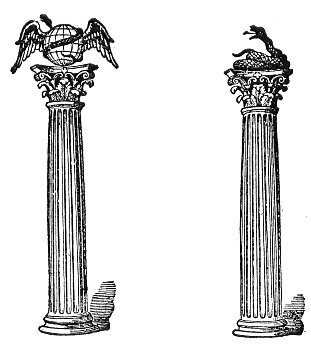So the libations to Souls, by pouring wine on the ground, and looking toward the two gates of Heaven, those of day and night, referred to the ascent and descent of Souls.
Ceres and the Serpent, Jupiter Ammon and the Bull, all figured in the Mysteries of Bacchus. Suppose Aries, or Jupiter Ammon occupied by the Sun setting in the West;–Virgo (Ceres) will be on the Eastern horizon, and in her train the Crown, or Proserpine. Suppose Taurus setting;–then the Serpent is in the East; and reciprocally; so that Jupiter Ammon, or the Sun of Aries, causes the Crown to rise after the Virgin, in the train of which comes the Serpent. Place reciprocally the Sun at the other equinox,
p. 494
with the balance in the West, in conjunction with the Serpent under the Crown; and we shall see the Bull and the Pleiades rise in the East. Thus are explained all the fables as to the generation of the Bull by the Serpent and of the Serpent by the Bull, the biting of the testicles of the Bull by the Scorpion, on the Mithriac Monuments; and that Jupiter made Ceres with child by tossing into her bosom the testicles of a Ram.
In the Mysteries of the bull-horned Bacchus, the officers held serpents in their hands, raised them above their heads, and cried aloud “Eva!” the generic oriental name of the serpent, and the particular name of the constellation in which the Persians placed Eve and the serpent. The Arabians call it Hevan, Ophiucus himself, Hawa, and the brilliant star in his head, Ras-al-Hawa. The use of this word Eva or Evoë caused Clemens of Alexandria to say that the priests in the Mysteries invoked Eve, by whom evil was brought into the world.
The mystic winnowing-fan, encircled by serpents, was used in the feasts of Bacchus. In the Isiac Mysteries a basilisc twined round the handle of the mystic vase. The Ophites fed a serpent in a mysterious ark, from which they took him when they celebrated the Mysteries, and allowed him to glide among the sacred bread. The Romans kept serpents in the Temples of Bona Dea and Æsculapius. In the Mysteries of Apollo, the pursuit of Latona by the serpent Python was represented. In the Egyptian Mysteries, the dragon Typhon pursued Isis.
According to Sanchoniathon, TAAUT, the interpreter of Heaven to men, attributed something divine to the nature of the dragon and serpents, in which die Phœnicians and Egyptians followed him. They have more vitality, more spiritual force, than any other creature; of a fiery nature, shown by the rapidity of their motions, without the limbs of other animals. They assume many shapes and attitudes, and dart with extraordinary quickness and force. When they have reached old age, they throw off that age and are young again, and increase in size and strength, for a certain period of years.
The Egyptian Priests fed the sacred serpents in the temple at Thebes. Taaut himself had in his writings discussed these mysteries in regard to the serpent. Sanchoniathon said in another work, that the serpent was immortal, and re-entered into himself; which, according to some ancient theosophists, particularly those
p. 495
of India, was an attribute of the Deity. And he also said that the serpent never died, unless by a violent death.
The Phœnicians called the serpent Agathodemon [the good spirit]; and Kneph was the Serpent-God of the Egyptians.
The Egyptians, Sanchoniathon said, represented the serpent with the head of a hawk, on account of the swift flight of that bird: and the chief Hierophant, the sacred interpreter, gave very mysterious explanations of that symbol; saying that such a serpent was a very divine creature, and that, opening his eyes, he lighted with their rays the whole of first-born space: when he closes them, it is darkness again. In reality, the hawk-headed serpent, genius of light, or good genius, was the symbol of the Sun.
In the hieroglyphic characters, a snake was the letter T or DJ. It occurs many times on the Rosetta stone. The horned serpent was the hieroglyphic for a God.
According to Eusebius, the Egyptians represented the world by a blue circle, sprinkled with flames, within which was extended a serpent with the head of a hawk. Proclus says they represented the four quarters of the world by a cross, and the soul of the world, or Kneph, by a serpent surrounding it in the form of a circle.

Moe is the founder of GnosticWarrior.com. He is a father, husband, author, martial arts black belt, and an expert in Gnosticism, the occult, and esotericism.






